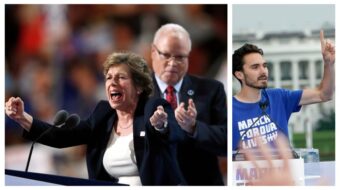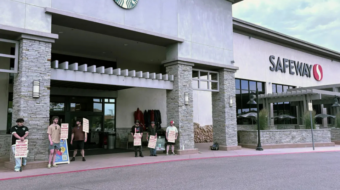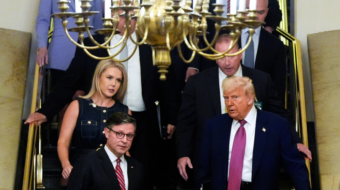CHICAGO — The Teamsters trucked it up from downstate. The Chicago Federation of Labor had lobbied for the funding from the state of Illinois. The Illinois Labor History Society campaigned tirelessly for it. The city of Chicago and police finally came to the table. Even present-day anarchists were mentioned at its unveiling, but they weren’t happy about it.
More than 100 years after the bombing and police riot at Haymarket Square, the site finally has an appropriate marker. Approximately 200 people attended the “official” Haymarket statue unveiling here, Sept. 14, near the corner of DesPlaines and Randolph streets.
Illinois Senate President Emile Jones, a principal in securing the funding for the project, said it was a long time coming, but the statue is a “tribute to working men and women.”
On the very site where workers gathered May 4, 1886, to protest the violent police attack on their union brothers and sisters at McCormick Harvester, during a militant strike for the 8-hour day, sits a unique statue created by artist Mary Brogger. In a reddish hue, a dozen figures surround a wagon, similar to the one used by the rally speakers that fateful night.
Figures stand on top of the wagon triumphantly; others are helping to put wheels on. They are faceless but clearly working together. Brogger’s Haymarket statue, according to project manager Nathan Mason, represents “society working together.” It’s more figurative about the meaning of Haymarket than historical, he said.
“It only took 118 years but it’s here,” CFL President Dennis Gannon said. It’s the labor movement’s and international labor community’s salute to Albert Parsons, August Spies and the other Haymarket Martyrs, he said, adding that their courage paved the way for freedoms we enjoy today.
The struggle for the 8-hour day is the basis of what labor’s about, Gannon said. “We can accomplish things together. No one does it alone, in a vacuum.”
Gannon then launched into an attack on the Bush presidency. “These freedoms are under attack by the current president. Workplace rights, overtime pay, OSHA are all being eliminated,” he said. Haymarket is a lesson about protecting civil and human rights, he said, pointing out that’s what union rights are. “All workers need to have a voice,” Gannon said. “Are we under attack? Sure.”
It was a “travesty,” Gannon said, not to have an appropriate monument. We have union guests come in from all over the world, he said, and they want to see where Haymarket was.
The site has been a landmark since 1992. William Adelman, labor historian and past president of the Illinois Labor History Society, served on the committee that chose the statue. “The case of the Haymarket Martyrs was a terrible travesty of justice,” he said. Six of the eight weren’t even at the May 4 rally. These were innocent people.”
“The meaning of Haymarket that the committee could all agree on was freedom of speech and assembly,” Adelman said. Two police representatives also sat on the committee.
“But, for me, Haymarket’s real issues were also the rights of minorities, the 8-hour day and the rights of workers to form free and democratic unions.”
Haymarket and Chicago is recognized as the birthplace for May Day, the international labor holiday. A special Haymarket statue dedication, sponsored by the Illinois Labor History Society, will be held on May Day, 2005.
The author can be reached at talbano@pww.org.









